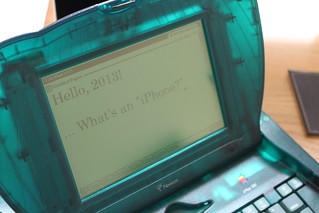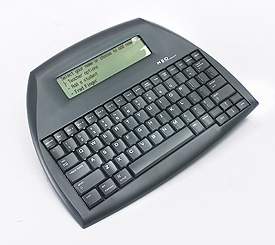
I took my first look at the “Most Popular Pages” feature on WordPress, and – to no surprise – a few poems were the most viewed posts here on Newton Poetry.
There are tons of people, myself included, who look for specific poems, analysis of poems, and collections of certain authors’ poems, and sometimes those searches land them here. Which is cool, but sometimes I wonder if the jabberwocky they’re presented makes any sense to them.
After all, my Newton 110 misspells words all the time. One commenter even asked me what the hell was going on, and when was I going to learn how to write correctly. He never took the time to see what this site was all about – namely, putting poems into the Newton and blogging what the MessagePad spits out. Put in “my heart breaks” and the Newton might read it as “my fart burps.” It’s one of the fun hobbies someone can play with on the Newton.
But part of this site has also turned into a “how-to” lesson for new Newton users like myself. As I discover tools, or try out new abilities, I like to share them. Just in case someone comes along (as someone recently did, on this 68k MLA forum posting) that is totally green to the Newton, I’d like Newton Poetry to be a handshake and a “welcome home.”
Take faxing. I tried it out, and it was super easy. Someone could definitely discover how to do it themselves (if Apple’s good at anything, its an intuitive interface). But should they do a quick Google or blog search on faxing with a Newton, I would hope Newton Poetry would pop up and help them out.
And like any Apple fan, I’m always interested in the wider world of Macintosh, iPods, iPhones, Apple history, and trends on where my favorite company is heading. No Newton is an island, and so from time to time Newton Poetry will touch on things that I find interesting. Like the iPod Shuffle announcement, or the decision over whether or not to wait and buy an iPhone.
The Newton community is still a sizeable group, and there are die-hards out there that keep the faith and keep the platform going. They’re very accepting of newbies (thankfully), mostly because they’re so proud of the product they champion, and they freely part with best practices on how to get the most out of the MessagePad. That means I don’t have to reinvent the wheel, and figure all this stuff out on my own.
DIY culture, however, says that you gain enjoyment out of the process and the end product, and few consumer electronics have inspired as much modding as the Newton. It was never intended to be a Twitter client – because it came out before Twitter was ever even thought of, natch – but I’ll be darned if someone didn’t figure out a way to make it work. That’s what makes the community so fun.
So there we go. Newton Poetry will highlight Newton Poetry, as always, but will also touch on how-to tips, Newton history, other Apple products (especially the portable varieties), and low-end tech culture in general. Call it a mission statement – whatever. I love poetry and literature, I love Apple products old and new, and I love playing around with my Newton.
If that’s not inspiration enough for a blog, I don’t know what is.
Welcome to Newton Poetry.




